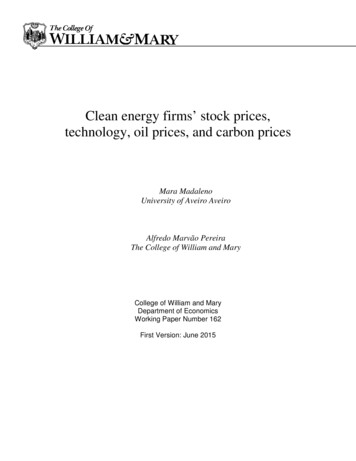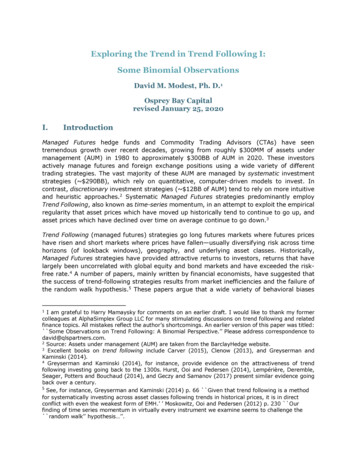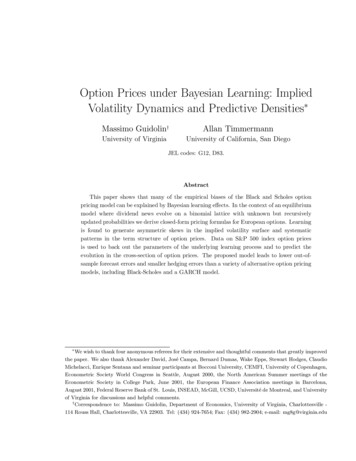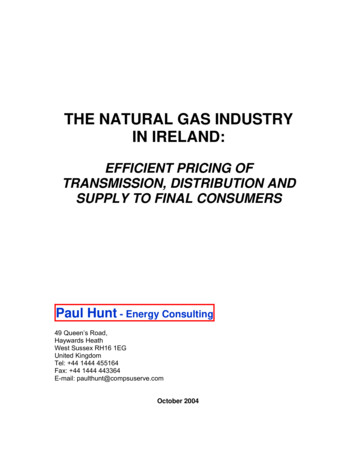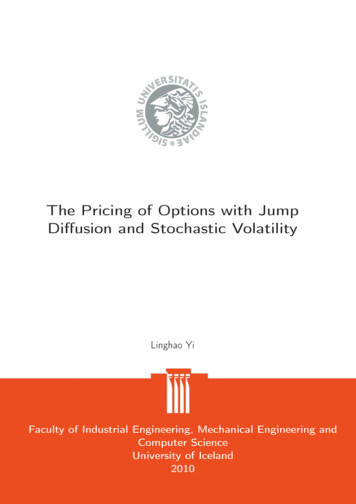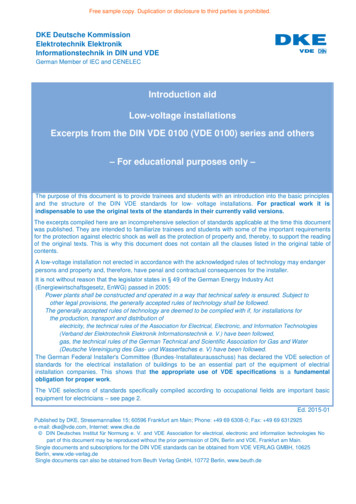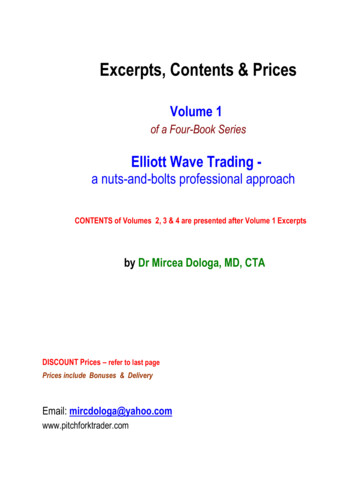
Transcription
Excerpts, Contents & PricesVolume 1of a Four-Book SeriesElliott Wave Trading -a nuts-and-bolts professional approachCONTENTS of Volumes 2, 3 & 4 are presented after Volume 1 Excerptsby Dr Mircea Dologa, MD, CTADISCOUNT Prices – refer to last pagePrices include Bonuses & DeliveryEmail: mircdologa@yahoo.comwww.pitchforktrader.com
Elliott Wave TradingA nuts-and-bolts professional approach1Basic & Intermediate --------------------Dr Mircea Dologa
www.pitchforktrader.com - Paris – ----------------------------Elliott Wave TradingA Nuts-and-Bolts Professional ApproachBeginner LevelVolume -----------------------Copyright 2016 by Dr Mircea DologaDate of Publishing – January 2016Printed in FranceCopyrights NoticeALL RIGHTS RESERVED: No part of this material may be reproduced withoutwritten permission from the publisher and the author. No part of this book may bereproduced, stored in a retrieval system, or transmitted in any form or by any means,photocopying, electronic, mechanical, or otherwise, without the prior permission of thepublisher and the author.Library of Congress Cataloguing-in-PublicationProtected by United States Copyright LawCertificate of Registration issued under the seal of Copyright Office in accordancewith title 17, United States Code.ISBN(10) 2-9527997-4-1ISBN(13) er.comParis – FRANCE
Why this Elliott Wave Trading Book?Common sense incites us to acquire a consistent technique that will give you confidenceand help you to obtain consistent profits. For the experienced traders the merits ofElliott wave technique are obvious. Most of them increased their profitability by morethan 40% since using the Elliott waves. But increasing profitability is a question ofmethod, not only on assimilating this technique, but also on practicing it. Compared tothe existing Elliott wave books, we tried to reach two objectives:o First, the presentation of applying the epistemology science in the process of fasterassimilation of basics and of advanced material of Elliott waves. This method ofbuilding knowledge blocks, sort of modules, is used in all our four Elliott wave booksin such a way that each module can be easily assimilated individually. Then, we willconsider them globally and then intricate them, for an immediate memory retentionand applicability. During the last century, along the decades, epistemology proved toaccomplish excellent results. There is more about this subject farther, in IntroductionSection.o Second, the sharing of our “know-how” of the practice of Elliott waves. We call it “thenuts-and-bolts professional approach”.Knowing that there is always a problem of finding the correct Elliott wave labelling,we have worked out a new approach towards a high probability outcome.We have also emphasized the dynamic aspects of the wave movements based onkinetic energy source building-up of the waves. This becomes highly beneficial to thetrader, knowing that an established highly probable scenario could be invalidated bythe market, in a blink of an eye. The transition phase from a highly probablescenario to the initially less probable one is here underlined with their invalidationand validation parameters. Once again, the trader’s flexibility based on soundcriteria, takes here all its importance.We consider that it is inconceivable to practice successfully Elliott waves without thetop-down approach using the multiple time frames. Taking a trading decision usingjust a small portion of a single time frame chart is an archaic way of trading. Wehave plainly emphasized this aspect of Elliott wave trading.Furthermore, we invite you to examine the Contents of our books for an extensiveperusal of our work.The essence of becoming a consistent trader is to understand the overall context of themarket, and specialize in one of the techniques that are working for various markets inany of the two possible states: trending or non-trending! This being said, the Elliott wavescan best fulfil these conditions.By writing these series of four Elliott wave books, our objective was to take the traderfrom the starting blocks to the high territories of the green grass plateaus !ConclusionAfter several decades of practice and teaching, we have decided to share our research andexperience with the trading community colleagues. We firmly believe that the intelligent Elliott WavePractice is one of the most reliable and consistent techniques for the astute trader. It harmoniouslyrespects and obeys the four principles enumerated below:ooooFinding where the market is coming from, where it is located now and where it is heading,A time-price ethereal space as the trading arena of the market flow evolvement,A ubiquitous usefulness in trending and even in sideways movements of various markets,And finally, an ergonomic and profitable intricacy with risk and money management.
Elliott Wave Trading - A Nuts-and-Bolts Professional Approach – Volume 1Volume 1Beginner & Intermediate Levels476 pages – 684 charts – 14 Excel files & TablesByDr Mircea Dologa, MD, CTAContents – Volume 1 1------------------------Introduction 9Skimming over our Elliott Wave TeachingsInside our 4 Elliott Wave BooksPush the Limits of your Learning CurveBehind the InvisibleWhy this Elliott Wave Book?Epistemology Always has the Last Word!ConclusionDisclaimerChapter 1 – Basics & Structural Formations – Labelling & Fractals of Impulsive WavesModules that help building your future working knowledge 171. Elliott Wave Labelling – Numbers and Letters2. Immutable Rules of the Waves2.1 Three Indispensables Rules2.2 Guidelines2.3 Errors to be Avoided and their Corrections3. Elliott Wave Cycles4. Labyrinthine Labelling:4.1 Letter Labelled Waves within Number Labelled Waves4.2 Number Labelled Waves within Letter Labelled Waves4.3 Understanding at a Glance somewhat Complexe Labelling4.3.1 B-Wave of (B)-Wave4.3.2 W3-Wave of W(3)-Wave4.3.3 D-Wave of W(4)-Wave4.3.4 c-Wave of (iii)-Wave of W5: W(5)4.3.5 v-Wave of (c)-Wave of B: (B)5. Fractal Patterns –Build-up Structures5.1 Russian Dolls5.2 Patterns within Patterns5.3 Waves within Waves6. Description of Impulsive Waves - Quest for Symmetry & Equilibrium6.1 Description of Impulsive Waves6.1.1 Classic W5-Wave Pattern (Non-Overlapping)6.1.2 Extended Impulsive Waves (Non-Overlapping)6.1.3 Failed W1-, W3- or W5-Wave Pattern (Non-Overlapping)6.1.4 Diagonal Triangles (Overlapping)6.1.4.1 Leading Diagonal Triangles (W1- or A-Wave Overlapping)6.1.4.2 Ending Diagonal Triangles (W5- or C-Wave Overlapping)6.1.4.3 Angle Genesis of a Diagonal TriangleCopyright 2016 by Dr. Mircea Dologa - All Rights Reserved - www.pitchforktrader.com1
Elliott Wave Trading - A Nuts-and-Bolts Professional Approach – Volume 16.1.4.4 Angle Confirmation - Diagonal Triangle Differential Diagnostic6.1.4.5 Specific Examples6.1.5 Conclusive Drawings of Impulsive Patterns7. Key Points to RememberChapter 2 – Basics & Structural Formations - Labelling of Corrective Waves 53Modules that help building your future working knowledge1. Description of Corrective Waves - Quest for Symmetry & Equilibrium1.1 Simple Corrections: Theory and Practical Examples1.1.1 Classic Flat, Expanded and Running Flat – Theory1.1.2 Multiple Scenarios of an Inceptive Flat1.1.3 Classic and Extended Zigzags1.1.4 Failed Zigzag1.1.5 Corrective Triangles: Contracting & Expanding Versions1.1.6 Conclusive Drawings of Simple Corrective Patterns1.2 Complex Corrections: Theory and Practical Examples1.2.1 Double Three Patterns – A Schematic Way of Assimilation1.2.2 Double Three Pattern – Real-Time Charts1.2.3 Triple Three Patterns – A Schematic Way of Assimilation1.2.4 Triple Three Patterns – Real-Time Charts1.2.5 Conclusive Drawings of Complex Corrective Patterns2. Key Points to RememberChapter 3 – Equality Principle 90Equality is one of the guidelines in our quest for the optimal objectives1. General Description1.1 Equality Principle within of a Non-Overlapping Impulsive Pattern1.1.1 Description1.1.2 Corollary of Equality Principle1.1.3 Profitable Trading using Equality Principle1.1.4 Profitable Trading using Corollary of Equality Principle2. Extended W5-Wave - Specific W5-Wave Trading Complying with Equality Principle2.1 Trading Methodology of the Extended W5-Wave2.1.1 Verification of W3 1.0*W1 Equality Associated with their Internal Structure2.1.2 Verification of W5-Wave Extension Associated with its Internal Structure2.1.3 Consequence of W5-Wave Extension over Market Flow2.1.4 Conclusion2.2 Target Forecasting – Detection of Terminal Cluster of W5 Wave2.2.1 Role of Price Magnitude of W0-3-Wave2.2.2 Price Magnitude of W2-Wave2.2.3 Role of Price Magnitude of W1-Wave and/or W3-Wave2.2.4 Role of Expansion of Price W4-Wave Magnitude, Projecting the W5-Wave Extension2.2.4.1 W4-Wave Impact over the Development of W5-Wave Elongation2.2.4.2 W4-Wave Impact over the Development of W5-Wave Extention2.2.5 Role of the Terminal w5-Subwave of W5-Wave2.2.6 Role of the Impulsive Pattern Containing the Extended W5-Wave2.2.6.1 Projection of an Extended W5-Wave with Regard to Previous A-B-C or A-B-C-D-E Pattern2.2.6.2 W(4)-Wave – Terminal Projection of the Extended (v)-Subwave of A-Wave with Regard toPrice Magnitude of W(3)-Wave2.2.6.3 W(4)-Wave – Terminal Projection of the Extended (v)-Subwave of C-Wave with Regard toPrice Magnitude of W(3)-Wave2.2.6.4 (A)-(B)-(C) Pattern – Terminal Projection of the Extended W5-Subwave of (C)-Wavebelonging to a Corrective Pattern [Zigzag or Flat], with regard to W(1)-(2)-(3)-(4)-(5)Pattern2.2.6.5 Terminal Projection of the Extended (v)-Subwave of (C)-Wave Belonging to a Zigzag,with regard to W(1)-(2)-(3)-(4)-(5) Pattern2.2.6.6 Strict Monitoring of the Terminal Cluster ForecastingCopyright 2016 by Dr. Mircea Dologa - All Rights Reserved - www.pitchforktrader.com2
Elliott Wave Trading - A Nuts-and-Bolts Professional Approach – Volume 12.3 Trading of the W5-Wave Extension2.3.1 Variability of W3- and W3-Wave Equality with Impact over the Variability of W5-Wave Extension2.3.2 Table and Graphic Relation – W3- and W3-Wave Equality Impact over the Variability of W5-WaveExtension2.4 W5-Wave Variability Impact of W0-5 Pattern Magnitude over the Corrective Pattern [A-B-C or A-B-C-DE Simple Pattern or a Complex Pattern]2.4.1 Above 38.2% level and less frequently within 38.2%-50% Zone2.4.2 Within 38.2%-61.8% Zone2.4.3 Precisely On 50% Key Level or Below2.4.4 Under 61.8% Key Level3. Extended W3-Wave - Specific W5-Wave Trading Complying with Corollary of Equality Principle2.1 Specific Trading of Non-Extended W5-Wave3.1.1 Verification of Extended W3-Wave associated with Internal Structure of W3- and W1-Waves3.1.2 Verification of Extended W3-Wave associated with Internal Structure of its Subwaves3.1.3 Consequence of W3-Wave Extension over the Market Flow3.1.4 Conclusion3.2 Target Forecasting – Detection of a Terminal Cluster of W5 Wave3.2.1 Role of W1-Wave Price Magnitude in case of W3-Wave Extension in the Process of W5-WaveForecasting3.2.2 Role of Price Magnitude of W2-Wave3.2.2.1 Lambda « λ » Retracement Coefficient3.2.2.2 Table and Graphic Relation – Variability of W2-Wave Impact over the Variability ofW3- Wave3.2.3 Role of Price Expanded W4-Wave3.2.4 Role of Pattern containing the Price Extended W3-Wave3.2.4.1 Projection of Price Extended W3 Wave with regard to Previous A-B-C or A-B-C-D-EPattern3.2.4.2 W3-Subwave of (A)-Wave Projection of an (A)-(B)-(C) Zigzag with regard to the PreviousImpulsive W(1)-(2)-(3)-(4)-(5) Pattern3.2.4.3 Strict Monitoring of the Terminal Cluster Forecasting4. W1-Wave Price Extention - Specific Trading of Non-Extended W5 Wave associated with theCorollary of Equality Principle4.1 Trading Methodology of the Non-Extended W5-Wave4.1.1 Verification of W1-Wave Extension and the W3- and W3-Wave Structure4.1.2 Verification of W1-Wave Extension through its Subwaves Analysis4.1.3 Consequence of W1-Wave Extension over the Market Flow4.1.4 Conclusion4.2 Trading Methodology of the Non-Extended W5-Wave4.2.1 Role of Extended W1-Wave Considered as Entity4.2.2 Role of Extended Subwave within W1-Wave4.2.3 Role of Price Expanded W4-Wave Magnitude in Forecasting the W5-Wave4.2.3.1 Over-Extended W1-Wave Impact over W4 Wave and W5-Wave Forecast4.2.3.2 Extended W1-Wave Impact over W4-Wave and W5-Wave Forecast4.2.3.3 Moderate-Extended W1-Wave Impact over W4-Wave and W5-Wave Forecast5. Equality Principle Considered as Guiding Line over a Non-Overlapped Corrective Pattern6. Role of Time and Price7. Employing the Most Efficient Tools2.2 On Vertical Axis2.3 On Horizontal Axis2.4 On Oblique Axis8. In Search of Targets9. Errors to be Avoided and their Corrections10. Key Points to RememberChapter 4 – Proportionality Principle 144Proportional dynamic measures that bring about the objectives1. Definition and Brief Historical Basis of Fibonacci Heritage2. Succinct Description of Proportionality PrincipleCopyright 2016 by Dr. Mircea Dologa - All Rights Reserved - www.pitchforktrader.com3
Elliott Wave Trading - A Nuts-and-Bolts Professional Approach – Volume 13. Applying Proportionality Principle to Elliott Waves Patterns3.1 A-B-C (or A-B-C-D-E) Pattern and their Internal Subwaves, which Correct the Preceding W1-2-3-4-5Impulsive Pattern3.2 W1-2-3-4-5 Impulsive Iattern with their Composing Internal Subwaves with Regard to Preceding A-B-C(or A-B-C-D-E) Corrective Pattern3.3 Internal Waves Pertaining to a Non-Overlapping W1-2-3-4-5 Impulsive Pattern3.3.1 W2-Wave with Regard to W1-Wave (internal retracements in time & price)3.3.2 W3-Wave with Regard to W1-Wave (alternate projections of time & price)3.3.3 W3-Wave with Regard to W1-Wave (expansion of time & price)3.3.4 W3-Wave with Regard to W2-Wave (external retracements in time & price)3.3.5 W4-Wave with Regard to W3-Wave (internal retracement in price)3.3.6 W4-Wave with Regard to W2-Wave (expansion of time)3.3.7 W5-Wave with Regard to:3.3.7.1 W1-Wave, if W3-Wave is Extended (alternate projections of time & price)3.3.7.2 W0-3-wave, if W3-Wave is not Extended (alternate projections of time & price)3.3.7.3 W4 -Wave, if W3-Wave Remain of Classic Magnitude (expansion of time & price)3.4 Internal Waves Pertaining to an Overlapping W1-2-3-4-5 Impulsive Pattern3.5 Internal Waves Pertaining to a Simple Corrective Pattern3.6 Internal Waves Pertaining to a Simple Overlapped A-B-C-D-E Corrective Pattern3.6.1 C-Wave with Regard to A-Wave (alternate projections of time & price)3.6.2 D-Wave with regard to B-Wave (alternate projections of time & price)3.6.3 E-Wave with regard to C-Wave (alternate projections of time & price)3.7 Internal Waves Pertaining to a Complexe Overlapped W-X(1)-Y or W-X(1)-Y-X(2)-Z Corrective Pattern3.7.1 Y-Wave with Regard to W-Wave3.7.2 Z-Wave with Regard to Y-Wave3.7.3 X(1)-Wave with Regard to W-Wave3.7.4 Z-Wave with Regard to W-Wave3.7.5 X(2)-Wave with Regard to Y-Wave3.7.6 X(2)-Wave with Regard to X(1)-Wave4.5.6.7.8.Practice of Fibonacci, Gann and Charles Dow Price/Time RatiosStrict Procedures of Progressive Monitoring TechniqueRole of Price and TimeDefining Classic, Failed, Extended and Expanded Wave ConceptsEmploying the Most Efficient Tools8.1 On Vertical Axis8.2 On Horizontal Axis8.3 On Oblique Axis9. Practice of Bar Count Techniques10. In Search of the Objective11. Secrets of Practising Proportionality Principle – Patience, Close Monitoring, Waiting-for-the-Nextto Terminal-Ratio/Value12. Errors to be Avoided and their Corrections12.1 Errors and Corrections on S&P500 e-mini Futures Labelling12.2 Errors and Corrections on GOLD Futures Labelling13. Key Points to RememberChapter 5 – Alternation Principle Applied to Corrective Waves 184Principle that prepares for W5 trading1.2.3.4.Corrections Considered as the Fractals of ChaosRole of Time and Price Intricacy within Alternation PrincipleRole of Moving Averages in Corrective Wave Identification ProcessEmploying the Most Efficient Tools4.1 On Vertical Axis – Price Orientated4.2 On Horizontal Axis – Time Orientated4.3 On Oblique Axis – Price and Time Orientated5. Study of Prior Corrective/Impulsive Waves for an Optimal W5-Wave Trading5.1 Scrutinize the Inter-relations among Previous Waves5.2 Impact of W(4)-Wave in Detecting Profitable W5-Wave TradesCopyright 2016 by Dr. Mircea Dologa - All Rights Reserved - www.pitchforktrader.com4
Elliott Wave Trading - A Nuts-and-Bolts Professional Approach – Volume 15.2.15.2.25.2.35.2.45.2.5Classic Method of Fibonacci Price Ratios - Price Clusters Build-upClassic Method of Fibonacci Time Ratios - Temporal Clusters Build-upMultiple Square Method - Progressive Confluences Build upTime and Price Circular Projection Method - Targeted Time/Price Coordinates Build-upTime and Price Triangular Projection Method - Targeted Time/Price Coordinates Build-up6. Errors to be Avoided and their Corrections7. Key Points to RememberChapter 6 – Simple Schematic Way of Identifying the Elliott Wave Structures 217An ergonomic way of identifying the Elliott wave structures1. General Description2. Impulsive Patterns in an Easy-to-Grasp Schematic Ergonomic Way2.1 Classic Impulsive Pattern2.2 Extended Impulsive Patterns3. Corrective Patterns in an Easy-to-Grasp Schematic Ergonomic Way3.1 A-B-C Patterns3.2 W-Y-Z Patterns3.3 X(1) and X(2) Linking Waves4. A Methodical Approach to Elliott Wave Labelling – Test-Yourself Examples5. Key Points to RememberChapter 7 – Applying Candles in Elliott Waves 244The little known tools identifying reversals and continuation moves1. General Description, Usage and Confirmation Factors2. Reversals Confirmed by Specific ning Top and BottomEvening, Morning,& Shooting StarsEngulfing PatternHaramiDark Cloud CoverPiercing PatternTweezersMirror BarsHammerHanging Man.3. Continuation Moves Confirmed by Specific Candles3.13.23.33.4Three Patterns: White Soldiers, Black Crows and Rising/Falling MethodsWindowsTasukisSeparating Lines4. Immutable Rules in Trading Elliott Waves with Candles5. Candlesticks Correlation with Elliott Wave Termination/Inception Phenomena6. Key Points to RememberChapter 8 – Efficient Indicators for Practicing Elliott Waves 274Confirmation of entry/exit decisions by indicators is one of the most valuable tool1. Volume Related Indicators: Volume, VolumMA & On Balance Volume (OBV)1.1 Volume1.1.1 Calibration of Volume on Operational Time Frame Chart1.1.2 Volume used as a Fuelling Trend Factor1.1.3 Lower Time Frame Plotting as a Volume Forecasting Technique or2 out of 3 Cumulate Volume Technique1.2 Volume MA - The Comforting Factor1.3 Volume MA – The Tool to Identify the Best Trading Intra-day Time Zone1.4 On-Balance Indicator (OBV) – a Cumulative (Time & Price) Extension of Volume Indicator1.5 On-Balance Indicator (OBV) – Classic and Hidden Divergence ToolCopyright 2016 by Dr. Mircea Dologa - All Rights Reserved - www.pitchforktrader.com5
Elliott Wave Trading - A Nuts-and-Bolts Professional Approach – Volume 12. Relative Strength Indicator [RSI (14, 9, 45)]2.1 Definition2.2 Overbought and Oversold Zones – Detecting the Tops and Bottoms2.3 RSI - Trend Revealing Tool2.3.1 Trough-and-Peak Analysis – Comparing Current versus Last Correction Lows2.3.2 Up-Trend and Down-Trend Landmarks – Description2.4 Resistance and Support Identification2.5 Elliott Waves Labelling Confirmation by RSI Indicator3. Reveal the Unwritten Rules OSC (5, 17), OSC (5, 35), OSC (5, 70) & OSC (10, 105)3.1 OSC (5, 35) Indicator – Definition3.23.33.43.53.6Comparison of OSC (5, 35), OSC (5, 17) and MACD (12, 26, 9)Comparison of OSC (5, 17), (5, 35), (5, 70) & (10, 105) SettingsHow to choose the Optimal OSC SettingsOSC (5, 35) Indicator - Trend Revealing Tool – Overbought/Oversold LevelElliott Waves Labelling Confirmation by OSC (5, 35) Indicator3.6.1 Elliott Wave and OSC (5, 35)3.6.2 W1-Wave3.6.3 W2-Wave3.6.4 W3-Wave3.6.5 W4-Wave3.6.6 W5-Wave3.6.7 Impulsive Wave Pattern - W1- to W5-Wave3.6.8 Corrective Wave Pattern – A-Wave, B-Wave and C-Wave4. Classic and Hidden Divergences – Highly Probable Wave Termination Tools4.1 RSI(14) Divergence used as a Reversal Tool4.1.1 Simple Divergences4.1.2 Hidden Divergences4.1.3 Failure Swings - Divergence Enhancement Factor4.2 OSC (5, 35) Divergence used as a Reversal Tool4.2.1 Failure Swings - Divergence Enhancement Factor5.6.7.8.Intricacy between SAR Parabolic Indicator & Elliott Wave Development34-Exponential Pivotal Moving Average [(H L C)/3] as a Wave Behaviour IndicatorGMMA – Guppy Multiple Moving AveragesTips, Errors & Solutions - Concrete Examples8.18.28.38.4Classic Technical Analysis Symbiotic Effect on Elliott WavesTop-Down Analysis an Indispensable Factor in Elliott Wave PracticeAlternate Scenario a Guarantor of Profitable TradesWave Proportionality is the Key9. Key Points to RememberChapter 9 – Topics on Elliott Wave Efficient & Practical Usage 340Guiding elements that assist your performance1. Best Structural Charts: Candle Bars, Line Chart or Moving Average lines?2. Energy Source Building-up the Waves3. Market Flow Dynamics in Progress3.13.23.33.43.5Differences between a Current Wave and a Developing SubwaveDifferences between a Developing C-Wave of an A-B-C Pattern and a W1-WaveDifference between a Developing Non-Overlapping & Overlapping W1-WaveDifferences between a Developing W3-Wave and a C-WaveDifferences among a Developing Zigzag, a Flat and a Corrective Triangle3.5.1 Identifying the Beginning of Zigzag Characteristics3.5.2 Identifying the Beginning of Flat Characteristics3.5.3 Identifying the Beginning of Corrective Triangle Characteristics3.5.4 Conclusion - Differential Diagnosis among Zigzag, Flat and Corrective Triangle3.5.5 Differences between a Developing Flat, a Zigzag and a Corrective Triangle3.5.6 Difference between a Developing Non-Overlapping and an Overlapping W5-Wave3.5.7 Differences between a Developing W5-Wave and X(1)-Wave3.5.8 Difference between a Developing W5-Wave and a B-Wave of an Expanded FlatCopyright 2016 by Dr. Mircea Dologa - All Rights Reserved - www.pitchforktrader.com6
Elliott Wave Trading - A Nuts-and-Bolts Professional Approach – Volume 13.5.9 Difference between a Developing W5-Wave and a B-Wave Pertaining to a Simple or ComplexPattern3.5.10 Differences between a W5-Wave Ending and a W3-Wave Mislabelling [Is W1-2-3-4-5 still inprogress?]3.5.11 Differences between (A)-Wave of (A)-(B)-(C) Pattern and A-B-C Flat Pattern3.5.11.1 Price-wise Differences3.5.11.2 Time-wise Differences3.5.12 Differences between an Ending Impulsive Pattern and an Inceptive A-B-C-Pattern3.5.13 Differential Diagnosis between an A-B-C-Pattern and a W-X-Y-X-Z-Pattern4. Geometric Patterns Formed by Impulsive and Corrective Waves4.14.24.34.44.54.64.74.8Is a Horizontal Triangle Always a Corrective Pattern?Is the Flag or the Pennant Significant in Applied Elliott Wave Methodology?Does Head & Shoulder Pattern Forecast the Targets?Does a Diamond Have a Corrective or a Reversal Role?Is the Wedge Always a Diagonal Triangle?Can a Rectangle Forecast the Size and Structure of the Next Patterns?Can a Circle Forecast the Boundaries and the Structures of the Next Patterns?Can a Parabolic Forecast the Boundaries and the Structures of the Next Patterns?5. Oblique and Horizontal Channels Guiding the Elliott Waves Formation5.1 Line and Candle Chart Channels5.2 Role of the First Volatile Bar in a Horizontal Channel Formed by a Rectangle6. Key Points to RememberChapter 10 – Top-Down Elliott Wave Approach 395The tool that tells you where you come from, where you are and where you go to 1. General Description2. Top-Down Approach Charts – Snapshots of July 7, Taken Before Executing the Trade(weekly, daily, 120-min, 60-min & 15-min time frames)3. Top-Down Approach Charts – Snapshots of July 7, Taken While Executing the Trade(daily, 120-min, 60-min & 15-min time frames)4. Top Top-Down Progressive Monitoring Technique – Sniper’s Attitude4.1 Phase One – Attentive Observation Before Entering the Trade (July 10)(weekly, daily, 240-min & 60-min time frames)4.2 Phase Two – Gather the Information & Enter the Trade (July 14)(weekly, daily, 240-min & 60-min time frames)4.3 Phase Three – Cope with Results & Optimize Next Trade (July 17)(weekly, daily, 240-min & 60-min time frames)4.4 Phase Four – Post Trade Educational Environment (July 20–21)5. Multi-Time Frame Up-Sloping Scenarios (monthly, weekly & daily time frames)6. Multi-Time Frame Down-Sloping Scenarios (monthly, weekly & daily time frames)7. Up- or Down-Sloping Monthly Scenario?7.1 Up-Sloping Monthly Scenario7.2 Down-Sloping Monthly Scenario8. Up- or Down-Sloping Weekly Scenario?8.1 Up-Sloping Weekly Scenario8.2 Down-Sloping Weekly Scenario9. Up- or Down-Sloping Daily Scenario?9.1 Up-Sloping Daily Scenario9.2 Down-Sloping Daily Scenario7. Key Points to RememberChapter 11 – Annex: Excel Calculations & Tables. . 436Plate n 1 – 80/20 Percent RulePlate n 2 - Fibonacci TechniquesPlate n 3 - Cluster Calculations - Ahead of the MarketPlate n 4 - Specific numbers, from 5 to 206, used in Bar Count TechniquePlate n 5 - Count Back Line TechniqueCopyright 2016 by Dr. Mircea Dologa - All Rights Reserved - www.pitchforktrader.com7
Elliott Wave Trading - A Nuts-and-Bolts Professional Approach – Volume 1Plate n 6 - Proportionality Main GuidesPlate n 7 - Easy-to-Grasp Schematic Ergonomic Way to Identify Impulsive Non- Overlapping PatternsPlate n 8 - Easy-to-Grasp Schematic Ergonomic Way to Identify Corrective PatternsPlate n 9 - Pitchfork Tool - Another Way to Identify Impulsive and Corrective PatternsPlate n 10 - Reversal Candlesticks and Elliott Wave SynchronisationPlate n 11 - Continuation Candlesticks and Elliott Wave SynchronisationPlate n 12 - Neutral Candlesticks and Elliott Wave SynchronisationPlate n 13 – Up-Sloping Market accros the Multi-Time Frames (month, week & day)Plate n 14 – Down-Sloping Market accros the Multi-Time Frames (month, week & day)Contents of Volumes 2, 3 & 4 450BibliographyCopyright 2016 by Dr. Mircea Dologa - All Rights Reserved - www.pitchforktrader.com. . 4768
Elliott Wave Trading - A Nuts-and-Bolts Professional Approach – Volume 1Introduction“Greatness is not digging to become somebody, but rather helping folks around you, toachieve just that ”Common sense compels us to acquire a consistent trading technique that gives us theconfidence to learn how to trade successfully. Elliott wave principle is one of the choices.This will not come without “sweat and tears”, but like the wisdom from sagacious Chinasays: “What first brings pleasure, in the end gives only pain, but what at first causes pain,ends up in great pleasure”.Trading should not be so difficult if you build it on solid foundation. just assimilate thebasics and practice enough to sharpen your skills! One thing though Once you haveassimilated the basic knowledge, before you start to do any real time trading, you are readyfor the last step . Prepare to trade “shoulder-to-shoulder” with a mentor. It will certainlysave you a lot of money and will surely accelerate your coming into the restraint club ofprofessional traders, thus fulfilling your financial needs.Skimming over our Elliott Wave TeachingsThe overall goal of this course is to teach the trader the perspective of how he or she willuse the Elliott wave technique. This process will commence with Volume 1 describing fromthe scratch, the difficult process of becoming a profitable trader. It will teach the reader,step by step, the practical aspects from the candle or line chart reading to the impact ofElliott wave practice on the trade profit. The emphasis will be, not only on underlining thewave basics, but also on how to build confidence in you by using the professional trader’s“nuts-and-bolts” arsenal.This book represented multiple challenges.When we started to write this Elliot wave series, we were aware that this task would takeseveral years to complete. It also became obvious that the subject presentations would haveto be progressive, module after module, using many charts and drawings. In this way, thetrader will not only rapidly understand the topics and put them to work, but these fourmanuals could serve as references in the post-learning period. The same idea wascorroborated by the section “Key points to remember” presented at the end of everychapter. We did not want to stumble into the trap of just writing down about Elliottwaves We put some thoughts into how to present this material through the eyes of apractitioner that tries to transmit a so called “subjective” topic, which in reality isn’t. Inour experience, after more than two decades of Elliott waves practice, it became obviousthat the assimilation of this material must pass through the use of images (drawings,schema and decisional Excel tables) backed up by real-time charts. We employed here thewell known saying “a picture is worth thousand words”. We tried to be concise, butexplicative, present easy understandable topics with the adequate sizes of the real-timecharts and the optimal indicators. The latter aren’t numerous. We use just theindispensable ones. The first two indicators are based on volume aspects described by thecalibrated Volume indicator with its moving average associated with the On-BalanceVolume (OBV). The other two indicators are based on market momentum - RSI (14, 9, 45) and OSC (5, 35) indicator, the measured area between two moving averages. The twovolume indicators are indispensable for evaluating the market flow fuelling processboosting the trader’s self confidence before every entry (wave commencement) or exit(wave terminating potential) decisions. The last two indicators are efficiently used for:Copyright 2016 by Dr. Mircea Dologa - All Rights Reserved - www.pitchforktrader.com9
Elliott Wave Trading - A Nuts-and-Bolts Professional Approach – Volume 1o Quanti
Elliott Wave Trading - a nuts-and-bolts professional approach CONTENTS of Volumes 2, 3 & 4 are presented after Volume 1 Excerpts by Dr Mircea Dologa, MD, CTA . trader, knowing that an established highly probable scenario could be invalidated by the market, in a blink of an eye. The transition phase from a highly probable
